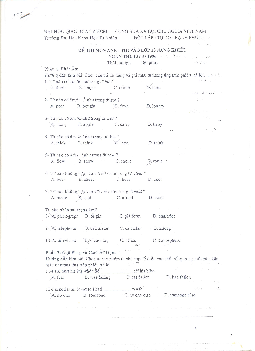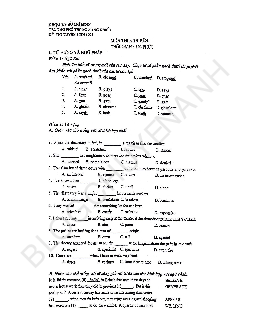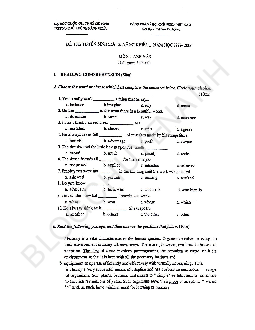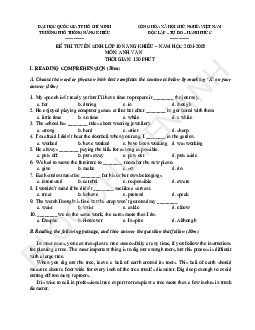





Preview text:
PHÒNG GD&ĐT PHÚC
KHẢO SÁT ĐỘI TUYỂN HỌC SINH GIỎI KHỐI 9 THCS; NĂM HỌC: YÊN 2018-2019 (LẦN 2) MÔN THI: TIẾNG ANH 9
Thời gian làm bài: 150 phút (Không kể thời gian giao đề) PART A. LISTENING
Complete the notes. Write NO MORE THAN TWO WORDS for each answer.
AUSTRALIAN ABORIGINAL ART ANCIENT ART • Rock and bark painting • Sand drawings • (1) _________ •
Decorations on weapons and tools Cave art • protected from (2) _________ •
styles include dot paintings (e.g. arrows, water holes and (3) _________ ) and naturalistic art • main function: (4) _________ Use of ochre Reason • readily available •
soil or rock contains (5) _________ •
produces many colours and shades of red •
artist's palette found that is (6) _________ old Preparation • ochre collected • turned into a (7) _________ •
fluid binder, e.g. tree sap or (8) _________ added MODERN ART •
Artists use acrylic colours and (9) _________. •
Paint and decorate pottery and a range of (10) _________. B. LEXICO AND GRAMMAR
I. Choose the correct answer A, B, C or D to complete the sentence.
1. It seems too good to be true. Are you sure this guy’s on the _________? A. flat B. wagon C. level D. town
2. When I took over the business I got more than I ________. A. asked after B. bargained for C. drew up D. came in for
3. I’m going for a walk in the park. Would you like to ____________ me company. A. follow B. stay C. ward D. keep
4. He let it __________ that the Prime Minister was a close friend of his. A. announce B. talk C. drop D. infer
5. She used the map to discover where she was in ________to her surroundings. A. connection B. affinity C. relation D. reference
6. Phillips almost felt he was ________ something he could neither understand nor control. A. confessing to B. specializing in C. imposing on D. tampering with
7. Let’s _________ the place, it looks so gloomy and unpleasant . A. miss B. abandon C. depart D. disappear
8. For stamps and coins to be of value, they need to be in _________ condition. A. mighty B. flat C. sharp D. mint
9. The delight in treasure finding doesn’t always ________acquiring tremendous amounts of valuables. A. dwell on B. poke around C. lay about D. hinge upon
10. It’s not easy to make Stanley furious, the boy is very gentle by _____________. A. himself B. personality C. reaction D. nature
Part 2. Read the text below and give the correct form of the word in CAPITALS.
Most snap (1 - JUDGE) ____________ about people are formed on the basis of their facial features. The
eyes, regarded as clues to one’s true character, are said (2 - POETRY) ___________ to be the windows of the
soul: closely positioned, they imply (3- SLY)__________; set wide apart they suggest (4- HONEST)
___________ and directness. Thin mouths are equated with meanness and full mouths with (5- SENSUAL)
___________. Unconsciously, we make such instant judgments and they are made about us.
There is no hiding place for the face. Always exposed and vulnerable, it (6- VOLUNTARY) ___________
expresses happiness, desire and joy, anger, fear, shame and (7- LOATHE) ___________. Precisely for that person,
a masked face evokes fear and horror; once someone’s distinguishing (8- CHARACTER) _____________ are
hidden, we cannot read or recognize the person and fear of the (9- KNOW) ___________ immediately arouses
(10- SUSPICIOUS)_____________.
Part 3. There are TEN mistakes in this passage. Write them down & give the correction.
First come the PC, then the internet and e-mail; now the e-book is upon us, a hand-held device similarly in
size and appearance to a video cassette. The user simply rings off the website on their PC, selects the desired
books, downloads them onto their e-book machine and sits down to read them. For turning a page, the user simply
taps the screen. E-book technology is evolving rapidly, and with some of the newest handholds you will even get internet access.
But why would one want an e-book machine with reference to a book? Well, one selling point companies
emphasized, when these devices hit the market a few years ago, which is the space they save when going on
holiday. E-books enlighten the load, literally. Ten large novels can be put onto a device that weighs less than the
average paperback. One can understand why commercial interests seem to want us to change.
After all, the whole production process at first plan by author until delivery to the printer had been doing
electronically for a while now, so why not save a few million trees and cut out the hard copy?
Part 4. Fill in each blank with a suitable preposition or adverbial particle.
1. Rod sympathized __________ Delia’s situation.
2. This bread tastes __________ garlic.
3. My residence permit is valid _________ one more year.
4. The lifeguard saved the child __________ drowning.
5. She came __________ his request.
6. Robert was set __________ by two masked men and robbed.
7. Let’s run ____________ the details of the arrangements just once more.
8. A shortage of money has forced them to scale __________ the project.
9. I must warn you that if you have anything to say, it will be taken __________ and may be used in evidence against you.
10. Your plan doesn’t allow ___________ changes in the weather. C. READING
Part 1. Read the passage and choose the correct answer A, B, C or D that best fits in the numbered blank. OK
The word OK is ubiquitous in modern English but its origins remain (1) __________ in mystery. Over the
years, many theories have been (2) __________ regarding its derivation but none of them is (3) __________
convincing. The first recorded written use of OK was in 1839, when it appeared in a newspaper article in Boston,
Massachusetts. There was a (4) __________ for wacky acronyms at the time, just as today's text messages use
things like 'LOL', and OK allegedly originated as a misspelling of All Correct. But (5) __________ many of these
acronyms flourished briefly and then gradually (6) __________ out of use, OK has proved to be remarkably (7)
__________. It first reached England in 1870, where it appeared in the words of a popular song, and today is in (8)
__________ use across the English-speaking world. As part of a phrase ' …. rules OK', it has been a mainstay of
urban graffiti since the 1930s and in 1969 it had the (9) __________of being the first word spoken on the moon. In
short, it's a (10) __________ useful word. 1. A. shrouded B. smothered C. clothed D. draped 2. A. laid out B. put forward C. drawn up D. brought about 3. A. widely B. mainly C. wholly D. largely 4. A. hype B. craze C. rage D. whim 5. A. despite B. albeit C. whereas D. providing 6. A. slipped B. faded C. crept D. strayed 7. A. resolute B. stalwart C. steadfast D. resilient 8. A. staunch B. relentless C. durable D. constant 9. A. credit B. pride C. honour D. acclaim 10. A. phenomenally B. ordinarily C. conclusively D. controversially
Part 2. Read the passage and think of ONE word that best fits in the numbered blank.
I was reading an article last week in which the writer described ___(1)___ her children has changed as they
grow up. When they were small she had to ___(2)____ up with noisy games in the house or join in interminable
games of football in the garden which wore her out. If the house went quiet, she wondered what the monsters were
getting up to, or what crisis she would have to ____(3)_____ with next. She dreaded the fact that they might
____(4)____ after her husband, who admitted having ___(5)____ an uncontrollable child who ____(6)_____ most
of time showing off to his friends by breaking things or getting into fights. What was worse was that everyone else
thought he was ___ (7)____sweet child, and he got away with the most terrible things. However, she had
experienced an even greater shocked with her children. They had ___(8)____ out as chess and playing the piano.
They never did anything ___(9)____ talking it over first, and coming to a serious decision. She had to face up to
the fact that they made her feel rather childish as they got ___(10)____, and that in some ways she preferred them when they were young and noisy
Part 3. Read the text and choose the correct answer A, B, C or D for each question.
Most people can remember a phone number for up to thirty seconds. When this short amount of time
elapses, however, the numbers are erased from the memory. How did the information get there in the first place?
Information that makes its way to the short term memory (STM) does so via the sensory storage area. The brain
has a filter which only allows stimuli that is of immediate interest to pass on to the STM, also known as the working memory.
There is much debate about the capacity and duration of the short term memory. The most accepted theory
comes from George A. Miller, a cognitive psychologist who suggested that humans can remember approximately
seven chunks of information. A chunk is defined as a meaningful unit of information, such as a word or name
rather than just a letter or number. Modern theorists suggest that one can increase the capacity of the short term
memory by chunking, or classifying similar information together. By organizing information, one can optimize the
STM, and improve the chances of a memory being passed on to long term storage.
When making a conscious effort to memorize something, such as information for an exam, many people
engage in "rote rehearsal". By repeating something over and over again, one is able to keep a memory alive.
Unfortunately, this type of memory maintenance only succeeds if there are no interruptions. As soon as a person
stops rehearsing the information, it has the tendency to disappear. When a pen and paper are not handy, people
often attempt to remember a phone number by repeating it aloud. If the doorbell rings or the dog barks to come in
before a person has the opportunity to make a phone call, he will likely forget the number instantly. [A]. Therefore,
rote rehearsal is not an efficient way to pass information from the short term to long term memory. [B]. A better
way is to practice "elaborate rehearsal". [C] This involves assigning semantic meaning to a piece of information so
that it can be filed along with other pre-existing long term memories. [D]
Encoding information semantically also makes it more retrievable. Retrieving information can be done by
recognition or recall. Humans can easily recall memories that are stored in the long term memory and used
often; however, if a memory seems to be forgotten, it may eventually be retrieved by prompting. The more
cues a person is given (such as pictures), the more likely a memory can be retrieved. This is why multiple choice
tests are often used for subjects that require a lot of memorization.
1. According to the passage, how do memories get transferred to the STM?
A. They revert from the long term memory.
B. They are filtered from the sensory storage area.
C. They get chunked when they enter the brain.
D. They enter via the nervous system.
2. The word “elapses” in paragraph 1 is closest in meaning to: A. passes B. adds up C. appears D. continues
3. All of the following are mentioned as places in which memories are stored EXCEPT the ______. A. STM
B. long term memory C. sensory storage area D. maintenance area
4. Why does the author mention a dog's bark?
A. To give an example of a type of memory
B. To provide a type of interruption
C. To prove that dogs have better memories than humans
D. To compare another sound that is loud like a doorbell
5. In the final paragraph, where can the following sentence be placed?
For example, a reader engages in elaborate rehearsal when he brings prior knowledge of a subject to a text. A. [A] B. [B] C. [C] D. [D]
6. How do theorists believe a person can remember more information in a short time? A. By organizing it B. By repeating it C. By giving it a name D. By drawing it
7. The author believes that rote rotation is ______.
A. the best way to remember something
B. more efficient than chunking C. ineffective in the long run D. an unnecessary interruption
8. The word “elaborate” in paragraph 3 is closest in meaning to: A. complex B. efficient C. pretty D. regular
9. Which of the following best provides the important informaton in the underlined sentence from the passage?
A. Prompting is the easiest way to retrieve short term memory after an extended period of time.
B. A memory can be retrieved by prompting, in a case where it has been rarely used.
C. It's easier to remember short term memories than long term memories due to regular prompts.
D. Recalling a long term memory that is often used is easy, while forgotten memories often require prompting.
10. Complete the summary by choosing the THREE answer choices that contain the most imporant ideas in the
passage. Some sentences do not fit in the summary because they provide ideas that are not mentioned in the
passage or are only minor ideas from the passage.
The brain stores information that a person may need in the immediate future in a place called the short term memory (STM) [...]
i. Most people can only remember numbers for a short time.
ii. Many psychologists agree that only a certain amount of information can be stored in the STM at once.
iii. Some techniques for memorization don't work because of potential interruptions.
iv. Elaborate rehearsal is generally considered less effective than rote rehearsal.
v. Assigning meaning to information makes it easier for the brain to retrieve.
Part 4. You are going to read an article about emotions classification. Five sentences have been removed
from the article. Choose from the sentences A-G the one which fits each gap (1-5). There is one extra
sentence which you do not need to use. There is ONE example. SENTENCE
A. Any other method of showing all 412 emotions, such as words, would have been far less effective.
B. He said that the expression of these feelings was universal and recognizable by anyone, from any culture.
C. Research has also been done to find out which areas of the brain read emotional expression.
D. These are particularly difficult to control, and few people can do it by choice.
E. These can be combined into more than 10,000 visible facial shapes.
F. They decided that it was a mental state that could be preceded by ‘I feel’ or ‘he looks’ or ‘she sounds’.
G. It is as if they are programmed into the brains of ‘normal humans’ wherever they are and whatever their race.
I KNOW JUST HOW YOU FEEL
Do you feel sad? Happy? Angry? You may think that the way you show these emotions is unique. Well
think again. Even the expression of the most personal feelings can be classified, according to Mind Reading, a
DVD displaying every possible 5 human emotion. It demonstrates 412 distinct ways in which we feel: the first
visual dictionary of the human heart.
Attempts to classify expressions began in the mid-1800s, when Darwin divided the emotions into six types
- anger, fear, sadness, disgust, surprise and enjoyment. (0) _____B_____
Every other feeling was thought to derive from Darwin's small group. More complex expressions of
emotion were probably learned and therefore more specific to each culture. But now it is believed that many more
facial expressions are shared worldwide. (1) __________. The Mind Reading DVD is a systematic visual record of these expressions.
The project was conceived by a Cambridge professor as an aid for people with autism, who have difficulty
both reading and expressing emotions. But it quickly became apparent that it had broader uses. Actors and
teachers, for example, need to understand a wide range of expressions. The professor and his research team first
had to define an 'emotion'. (2)__________. Using this definition, 1,512 emotion terms were identified and
discussed. This list was eventually reduced to 412, from 'afraid' to 'wanting'.
Once these emotions were defined and classified, a DVD seemed the clearest and most efficient way to
display them. In Mind Reading, each expression is acted out by six different actors in three seconds.
(3) __________. The explanation for this is simple: we may find it difficult to describe emotions using words, but
we instantly recognize one when we see it on someone's face. 'It was really clear when the actors had got it right,'
says Cathy Collis, who directed the DVD. 'Although they were given some direction,' says Ms Collis, 'the actors
were not told which facial muscles they should move. We thought of trying to describe each emotion, but it would
have been almost impossible to make clear rules for this.' For example, when someone feels contempt, you can't
say for certain that their eyebrows always go down.
Someone who has tried to establish such rules is the American, Professor Paul Ekman, who has built a
database of how the face moves for every emotion. The face can make 43 distinct muscle movements called 'action
units'. (4) __________. Ekman has written out a pattern of facial muscular movements to represent each emotion.
Fear, for example, uses six simultaneous 'action units' including stretching the lips and dropping the jaw.
Ekman has also found that although it is possible to classify and describe the natural expression of
emotions, it may not be possible for people to reproduce them artificially. According to Ekman, we can't decide to
be happy or sad; it simply happens to us. Apparently, the most difficult expression to reproduce is the smile.
Ekman says a smile isn't only about stretching the lips, but tightening the tiny muscles around the eyes. (5)
__________. If we learned to recognize whether someone was using their eye muscles when they smiled, we
would be able to distinguish true enjoyment from false.
This finding is of great interest to police authorities who are seeking Ekman's help in interpreting even the
tiniest 'micro-expressions' - lasting only one twenty-fifth of a second - to detect whether or not someone is lying. D. WRITING
Part 1. Complete the second sentence without changing the meaning of the original one.
1. It is rumored that we will have a new boss.
Rumor _____________________________________________________________.
2. I'll have to wait before I know whether he'll keep his promise or not.
It remains _____________________________________________________________.
3. She was so famous that everyone voted for her.
Such _____________________________________________________________.
4. Evan is doing very well at school, especially if you consider that he’s younger than the others in his class.
Given _____________________________________________________________.
5. I will never forget the day I heard I’d got into my chosen university.
The day on _____________________________________________________________.
Part 2. Some people believe that young people know about international pop and movie stars but know very less
about famous people from the history in their own country. ● Why is this?
● How can more interest be created in young people to gain more knowledge about their own famous people from history?
Write an essay of at least 200 words. Use examples and reasons from your experience or knowledge. THE END BEST OF LUCK




